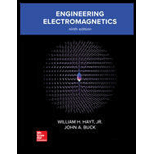
Concept explainers
Given E = Exax + Eyay + Ez3z V/m, where EX, Ey, and Ez are constants, determine the incremental work required to move charge q through a distance 6: (a) along the positive x axis, (b) in a, direction at 45 degrees from the x axis in the first quadrant; (c) along a line in the first octant having equal x, y, and z components, and moving away from the origin.
(a)
The value of incremental work along positive
Answer to Problem 4.1P
The value of incremental work along positive
Explanation of Solution
Given:
The expression for electric field is
Value of
Concept used:
Write the expression for incremental work.
Here,
Calculation:
To calculate incremental work along
So value of
Substitute
Simplify further.
Conclusion:
Thus,value of incremental work along positive
(b)
The value of incremental work in direction at
Answer to Problem 4.1P
The value of incremental work in direction at
Explanation of Solution
Concept used:
Write the expression for incremental work in
Here,
Write the expression for component of length in
Here,
Write the expression for component of length in
Here,
Calculation:
Substitute
So value of component of length in
Substitute
So value of component of length in
Substitute
Simplify further.
Here,
Substitute
Simplify further.
Conclusion:
Thus,the value of incremental work in direction at
(c)
The value of incremental work along a line in the first octant having equal
Answer to Problem 4.1P
The value of incremental work along a line in the first octant having equal
Explanation of Solution
Concept used:
Write the expression for incremental work in
Here,
Write the expression for length in
Here,
Calculation:
Value of length is same in
So
Substitute
Rearrange for
Substitute
Simplify further.
Here,
Substitute
Simplify further.
Conclusion:
Thus,the value of incremental work along a line in the first octant having equal
Want to see more full solutions like this?
Chapter 4 Solutions
Engineering Electromagnetics
- 1. Determine the total charge contained in a line extending from Cartesian point (3, 2, 1)to (5, 4, 7) carrying line charge of density p1(x, y,z)=2x +3y -5z C/m. note: this question is EMT ( electromagnetic field )arrow_forwardIn free space, let Q1 = 10 nC be at P1 (0,-4, 0). Find the work required done in moving a 2-microC charge along a straight line path from A(1, 2, 3) to B(3, 1, 2).arrow_forwardA uniform line charge and a uniform sheet charge, both infinite in extent, are located in free space along the y-axis and at x = -1 respectively. Determine E at point M(2, -1, 1) if the line charge density is 15 nc/m and the sheet charge density is 2 nC/m^2arrow_forward
- A uniform line charge of 16 nC/m is located along the line defined by y=-2,2 = 5. Determine E at P(1,2,3).arrow_forwardAn infinitely long uniform line charge is located at y = 3, z = 5 if ρL = 30nC/m, find E at: (a) the origin; (b) PB(0,6,1); (c) PC(5,6,1).arrow_forwardPlease answer and write neatly. (Show your complete solution.) Volume charge density is located in free space as ρν = 2e−1000r nC/m3for 0 < r < 1 mm, and ρν = 0elsewhere.(a) Find the total charge enclosed by the spherical surface r = 1 mm.(b) By using Gauss’s law, calculate the value of Dr on the surface r = 1 mm.arrow_forward
- Consider two concentric spherical shells--one conducting and one non-conducting. The conducting spherical shell has radius 3 cm and total charge of -8 nC, while the non-conducting spherical shell, which is outside the conducting shell, has inner radius 8 cm, outer radius 14 cm, and total charge 5 nC. Determine how strong the electric field is, in kV/m, 10 cm from the center of the conducting shell.arrow_forwardVolume charge density is located in free space as ρν = 2e−100r nC/m3 for 0 < r < 3 mm, and ρν = 0 elsewhere. Find the total charge enclosed by the spherical surface r = 2 mm. By using Gauss’s law, calculate the value of Dr on the surface r = 2 mm.arrow_forwardGiven a 20μC point charge at P(2,1,4), a line charge 30μC/m along the y-axis, and a surface charge 10μC/m2 at z = 2, Determine E at (1,2,4)arrow_forward
- Calculate D at point (12, -2, 7), produced by a uniform line charge 20 mC/m on x axis.arrow_forwardRegion 1, described by 3x + Ay > 10, is free space whereas region 2, described by3x + Ay < 10, is a magnetic material for which u=10u0. Assuming that theboundary between the material and free space is current free find B7 if B, =0.1a,+ 0.4av +0.2a. Wb/m2arrow_forwardAn infinite length cylinder of radius b extending along the Z-axis and carrying auniform volumetric current density J= az J, a cylindrical cavity of radius ? ismade along the entire length of the cylinder such that its axis is displaced adistance ? from the axis of the main cylinder, as shown in the figure.Use superposition (by handling the cavity as a cylinder carrying current –Jsuperimposed on the main current J that fill the entire cross section) to findthe magnetic flux density inside the cavityarrow_forward
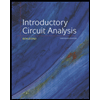 Introductory Circuit Analysis (13th Edition)Electrical EngineeringISBN:9780133923605Author:Robert L. BoylestadPublisher:PEARSON
Introductory Circuit Analysis (13th Edition)Electrical EngineeringISBN:9780133923605Author:Robert L. BoylestadPublisher:PEARSON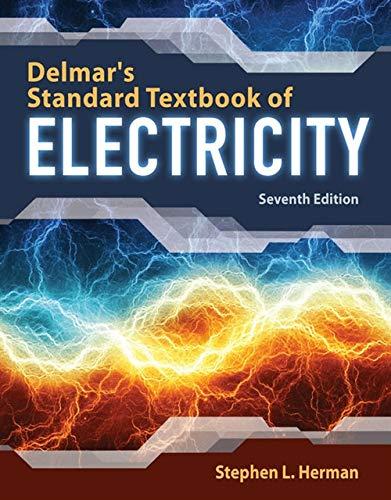 Delmar's Standard Textbook Of ElectricityElectrical EngineeringISBN:9781337900348Author:Stephen L. HermanPublisher:Cengage Learning
Delmar's Standard Textbook Of ElectricityElectrical EngineeringISBN:9781337900348Author:Stephen L. HermanPublisher:Cengage Learning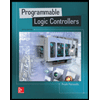 Programmable Logic ControllersElectrical EngineeringISBN:9780073373843Author:Frank D. PetruzellaPublisher:McGraw-Hill Education
Programmable Logic ControllersElectrical EngineeringISBN:9780073373843Author:Frank D. PetruzellaPublisher:McGraw-Hill Education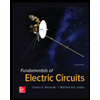 Fundamentals of Electric CircuitsElectrical EngineeringISBN:9780078028229Author:Charles K Alexander, Matthew SadikuPublisher:McGraw-Hill Education
Fundamentals of Electric CircuitsElectrical EngineeringISBN:9780078028229Author:Charles K Alexander, Matthew SadikuPublisher:McGraw-Hill Education Electric Circuits. (11th Edition)Electrical EngineeringISBN:9780134746968Author:James W. Nilsson, Susan RiedelPublisher:PEARSON
Electric Circuits. (11th Edition)Electrical EngineeringISBN:9780134746968Author:James W. Nilsson, Susan RiedelPublisher:PEARSON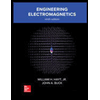 Engineering ElectromagneticsElectrical EngineeringISBN:9780078028151Author:Hayt, William H. (william Hart), Jr, BUCK, John A.Publisher:Mcgraw-hill Education,
Engineering ElectromagneticsElectrical EngineeringISBN:9780078028151Author:Hayt, William H. (william Hart), Jr, BUCK, John A.Publisher:Mcgraw-hill Education,





